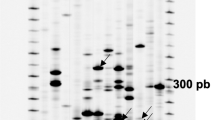Summary
Near-isogenic cultivars of Hordeum vulgare which differ for the Mlp gene for resistance to Erysiphe graminis f.sp. hordei were inoculated with race 3 of this pathogen and in vitro translation products of mRNA populations compared by 2-dimensional gel electrophoresis and fluorography. This revealed the presence of new mRNA species in infected leaves compared to non-inoculated controls. These new mRNA species were more abundant in resistant leaves than susceptible leaves. A cDNA library was prepared from poly(A)+RNA isolated from infected leaves carrying the Mlp gene for resistance (cvMlp). The library was screened by differential hybridization using [32P]-labelled cDNA prepared from poly(A)+RNA of both control and infected leaves. Six cDNA clones showing greater hybridization to cDNA prepared from infected leaves were selected. These six cDNA clones hybridized to DNA isolated from barley leaves but not to DNA from conidia of the fungus. In Northern blot analysis of RNA from infected leaves the six cDNA clones each hybridized to mRNA species of different size. Translation products for three of the cDNA clones corresponded to infection-related translation products identified on 2-dimensional fluorograms. The cDNA clones were used to study the kinetics of host mRNA induction during infection of the near-isogenic cultivars of barley. The host mRNA species corresponding to the cDNA clones were induced prior to 24 h after inoculation during the primary penetration processes. In addition the mRNAs corresponding to four of the cDNA clones increased to greater amounts in cvMlp than in the near-isogenic susceptible cultivar (cvmlp) over a 2-d period following inoculation. These results suggest that the Mlp gene has a regulatory role in host gene expression resulting in enhanced expression of several host mRNA species following infection by the powdery mildew fungus.
Similar content being viewed by others
References
Blin N, Stafford DW: A general method for isolation of high molecular weight DNA for eukaryotes. Nucleic Acids Res 3:2303–2308, 1976.
Brulet P, Roskam WG: Improved method for cloning DNA complementary to minor mRNAs: preparation of a hybridization probe from purified mRNAs encoding intermediate filament proteins. Gene 22:59–68, 1983.
Bushnell WR: Physiology of fungal haustoria. Ann Rev Phytopath 10:151–176, 1972.
Bushnell WR: Incompatibility conditioned by the M1-a gene in powdery mildew of barley: The halt in cytoplasmic streaming. Phytopathology 71:1062–1066, 1981.
Chakravorty AK, Scott KJ: Biochemistry of host rust interactions. In: Scott KJ, Chakravorty AK (eds) The Rust Fungi. Academic Press, London, 1982, pp 179–222.
Ellingboe AH: Genetics and physiology of primary infection by Erysiphe graminis. Phytopathology 62:401–406, 1972.
Hanahan D: Studies on transformation of Escherichia coli with plasmids. J Mol Biol 166:557–580, 1983.
Higgins CM, Manners JM, Scott KJ: Decrease in three messenger RNA species coding for chloroplast proteins in leaves of barley infected with Erysiphe graminis f.sp. hordei. Plant Physiol 78:891–894, 1985.
Maniatis T, Fritsch EF, Sambrook J: Molecular Cloning: A Laboratory Manual. Cold Spring Harbor Laboratory Press, 1982.
Manners JM, Davidson AD, Scott KJ: Patterns of post-infectional protein synthesis in barley carrying different genes for resistance to the powdery mildew fungus. Plant Mol Biol 4:275–283, 1985.
Manners JM, Scott KJ: Translational activity of polysomes of barley leaves during infection by Erysiphe graminis f.sp. hordei. Phytopathology 73:1386–1392, 1983.
Manners JM, Scott KJ: Reduced translatable messenger RNA activities in leaves of barley infected with Erysiphe graminis f.sp. hordei. Physiol Plant Pathol 26:297–308, 1985.
Masri SS, Ellingboe AH: Primary infection of wheat and barley by Erysiphe graminis. Phytopathology 56:389–395, 1966.
Moseman JG: Genetics of powdery mildews. An Rev Phytopath 4:269–290, 1966.
Moseman JG, Jorgensen JH: Identification of genes at the M1-a locus in barley for resistance to Erysiphe graminis f.sp. hordei. Crop Sci 11:547–550, 1970.
Moseman JG: Isogenic barley lines for reaction to Erysiphe graminis f.sp. hordei. Crop Sci 12:681–682, 1972.
O'Farrell PH: High resolution two dimensional electrophoresis of proteins. J Biol Chem 250:4007–4021, 1975.
O'Farrel PZ, Goodman HM, O'Farrel PH: High resolution two-dimensional electrophoresis of basic as well as acidic proteins. Cell 12:1133–1142, 1977.
Pure GA, Chakravorty AK, Scott KJ: Changes in wheat leaf polysomal messenger RNA populations during the early stages of rust infection. Plant Physiol 66:520–524, 1980.
Roychoudhoury R, Jay E, Wu R: Terminal labelling and addition of homopolymer tracts to duplex DNA fragments by terminal deoxynucleotidyl transferase. Nucleic Acids Res 3:836–877, 1976.
Smith SM, Bedbrook J, Speirs J: Characterization of three cDNA clones encoding different mRNAs for the precursor to the small subunit of wheat ribulose biphosphate carboxylase. Nucleic Acids Res 11:8719–8734, 1983.
Tepper CS, Anderson AJ: The genetic basis of plant-pathogen interactions. Phytopathology 74:1143–1144, 1984.
VonBroembsen SL, Hadwiger LA: Characterization of disease resistance responses in certain gene-for-gene interactions between flax and Melampsora lini. Physiol Plant Pathol 2:207–215, 1972.
VanLoon LC, Callow JA: Transcription and translation in the diseased plant. In: Callow JA (ed) Biochemical Plant Pathology. John Wiley and Sons, New York, 1983 pp 385–414.
Wickens MP, Buell GN, Schmike RT: Synthesis of double-stranded DNA complementary to lysozyme, ovomucoid and ovalbumin mRNAs. J Biol Chem 253:2483–2495, 1978.
Yang SL, Moseman JG, Ellingboe AH: The formation of elongating secondary hyphae of Erysiphe graminis and the segregation of M1 genes in barley. Phytopathology 62:1219–1223, 1972.
Author information
Authors and Affiliations
Rights and permissions
About this article
Cite this article
Davidson, A.D., Manners, J.M., Simpson, R.S. et al. cDNA cloning of mRNAs induced in resistant barley during infection by Erysiphe graminis f.sp. Hordei . Plant Mol Biol 8, 77–85 (1987). https://doi.org/10.1007/BF00016436
Received:
Revised:
Accepted:
Issue Date:
DOI: https://doi.org/10.1007/BF00016436




